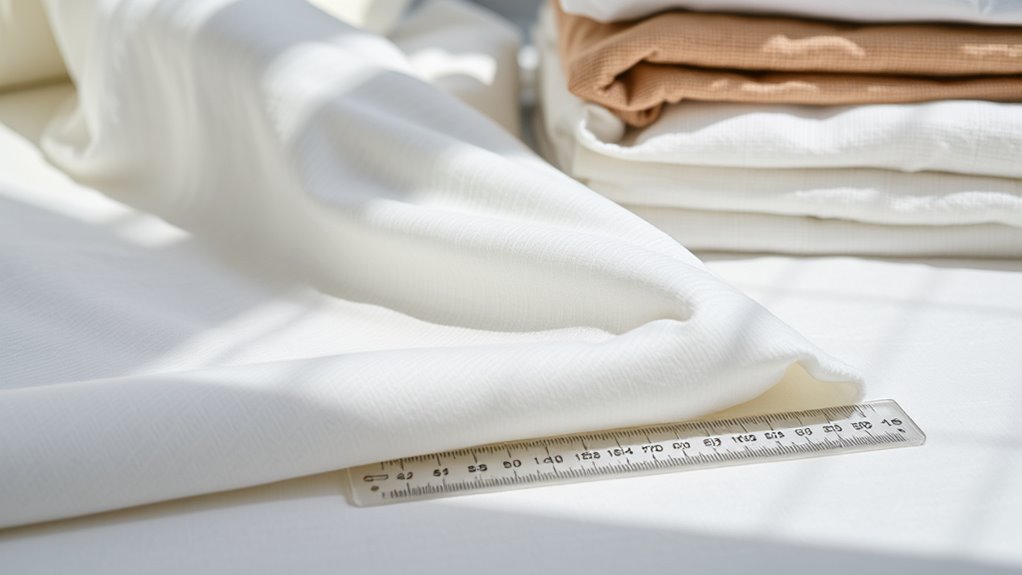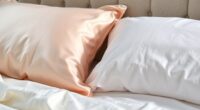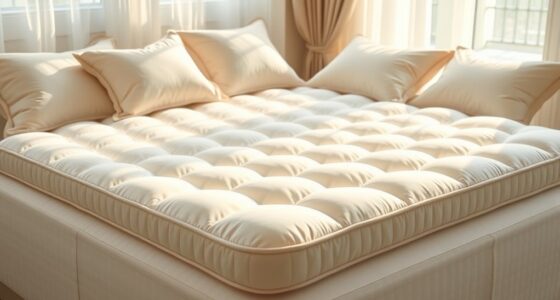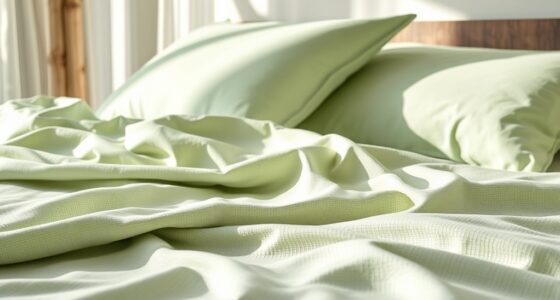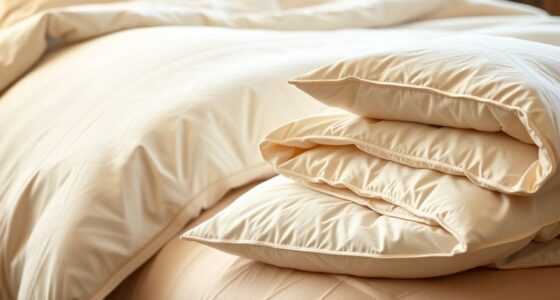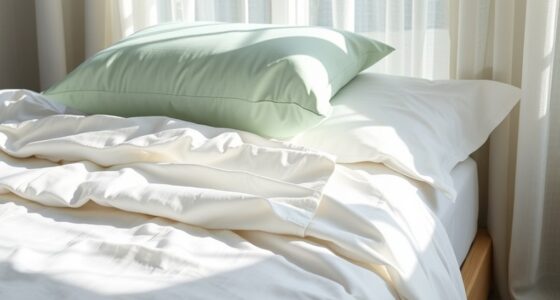Understanding sheet thread counts and materials helps you choose the best sheets for comfort and durability. While higher thread counts often feel softer, they aren’t always better—fabric quality and weave matter more. Natural fabrics like cotton and linen are breathable, while synthetics like microfiber are more durable and budget-friendly. By learning how to read labels and compare fabric types, you can select sheets that match your lifestyle. Keep exploring for tips on making the right choice.
Key Takeaways
- Higher thread counts do not always mean better quality; focus on fabric type and feel instead.
- Natural fibers like cotton and linen offer breathability, while synthetic fabrics like microfiber are more durable and budget-friendly.
- Reading labels helps identify fabric weave, material, and dyeing techniques, aiding better sheet selection.
- For warm climates, choose lightweight sheets like percale or linen; flannel suits colder seasons.
- Proper care—gentle washing and low heat drying—extends sheet lifespan and maintains fabric quality.
What Is Thread Count and Why Does It Matter?
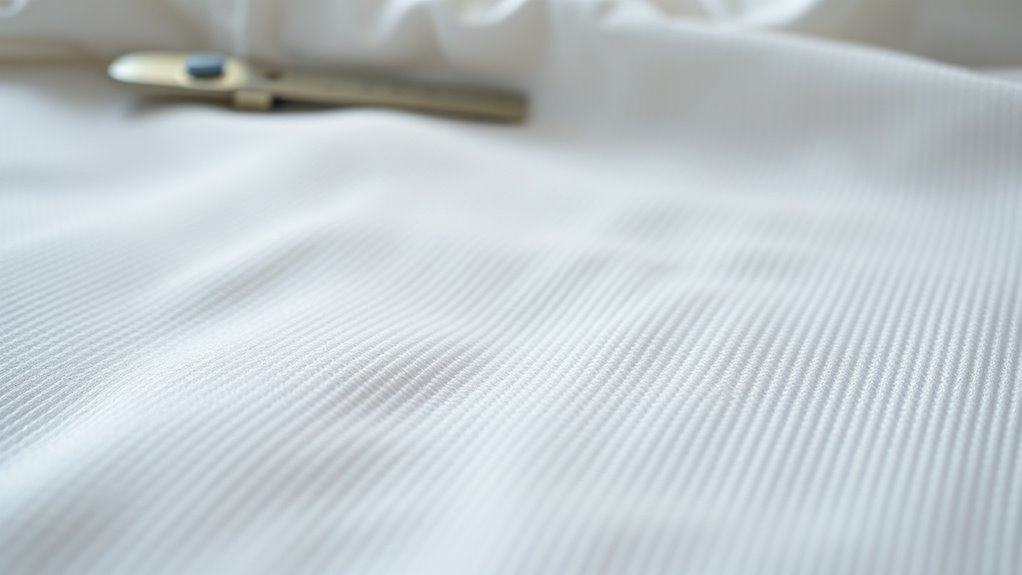
Thread count refers to the number of threads woven into one square inch of fabric, combining both the lengthwise (warp) and crosswise (weft) threads. Many people believe higher thread counts automatically mean better sheets, but that’s a common thread count myths — beyond a certain point, more threads don’t improve quality and can even reduce breathability. You should also consider eco friendly fabrics, which often have lower thread counts but still offer durability and comfort. Focus on how the fabric feels and breathes rather than just the number. High thread counts can create dense sheets that trap heat, while eco friendly options like organic cotton or bamboo tend to be softer and more sustainable, making them just as desirable. Additionally, understanding different fabric technology can help you choose sheets that combine comfort with performance.
Understanding Different Types of Sheet Materials
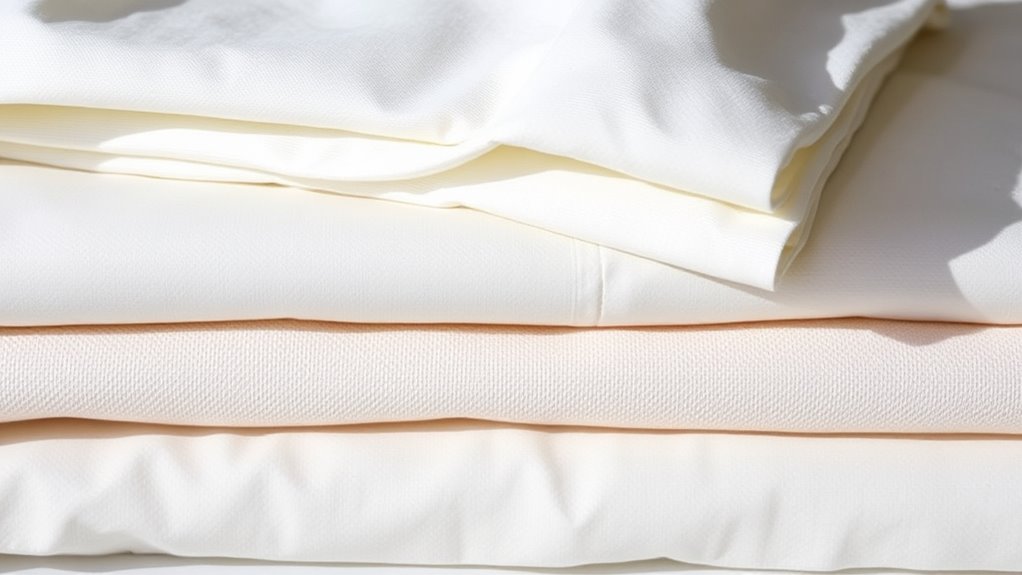
When choosing sheet materials, you’ll notice differences between options like cotton and linen, or microfiber and silk. Each material offers unique qualities in feel, durability, and maintenance. Understanding these distinctions helps you select the best sheets for your comfort and needs. For example, selecting a bed linen material that aligns with your preferences can enhance sleep quality and longevity.
Cotton vs. Linen
Have you ever wondered what sets cotton and linen apart when choosing sheet materials? Cotton offers softness and durability, often blended with other fabrics for enhanced fabric blends, which improve comfort and longevity. Linen feels cooler and naturally drapes well, making it a popular choice for warm climates. When it comes to dye fastness, linen tends to hold dyes better, resulting in vibrant, long-lasting colors. Additionally, the trustworthiness of AI models is a crucial consideration when relying on AI for material recommendations or quality assessments. Here’s a quick comparison:
| Feature | Cotton | Linen |
|---|---|---|
| Fabric Blends | Commonly blended for softness | Usually pure but can be blended |
| Dye Fastness | Good, but varies with treatment | Excellent dye retention |
| Feel | Soft and smooth | Crisp and textured |
| Durability | Durable with proper care | Very durable, gets softer with use |
| Climate Suitability | Versatile, all seasons | Best for warm weather |
Knowing these differences helps you choose the right sheet for your needs.
Microfiber vs. Silk
As you explore different sheet options, microfiber and silk stand out for their unique qualities and appeal. Microfiber offers excellent fiber durability, making it resistant to wrinkles and fading over time. It’s a budget-friendly choice that’s easy to care for, with a smooth, soft feel. Silk, on the other hand, provides superior fabric breathability, helping regulate your body temperature throughout the night. While silk feels luxurious and lightweight, it requires more delicate handling and tends to be more expensive. Both materials have their advantages: microfiber is durable and low-maintenance, whereas silk offers unmatched comfort and breathability. Your choice depends on whether you prioritize longevity and affordability or premium softness and temperature regulation. Additionally, understanding family photoshoot fails can remind you that even the most carefully selected materials can sometimes be subject to unexpected situations.
How to Read and Interpret Sheet Labels
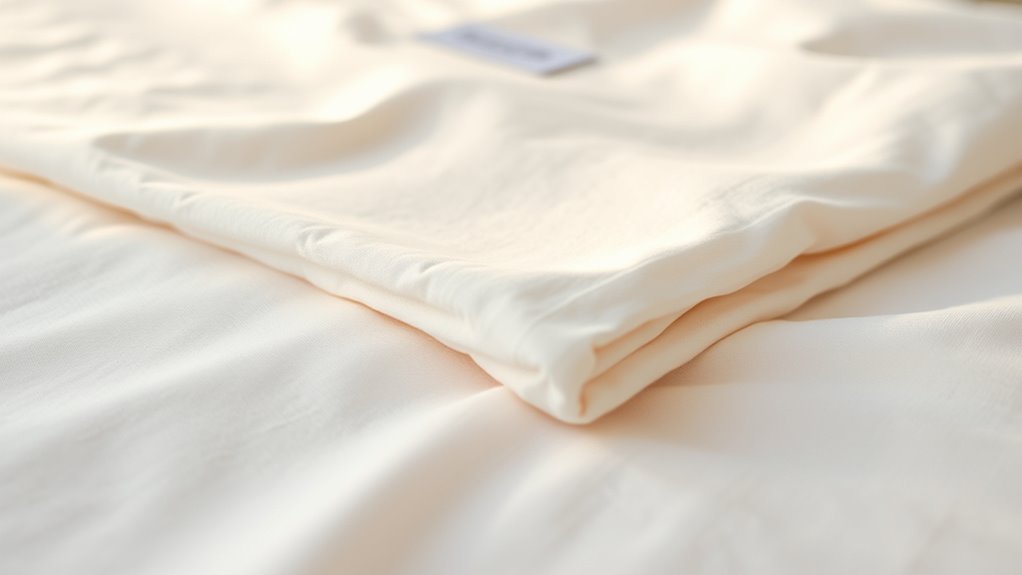
Understanding how to read sheet labels is essential for selecting the right bedding. Labels typically detail fabric weave, dyeing techniques, thread count, and materials used. Pay attention to the fabric weave, as it influences feel and durability—percale offers a crisp feel, while sateen is silky. Dyeing techniques, like reactive or piece dyeing, affect color longevity and vibrancy. Look for clear information about material composition, such as cotton or linen, to match your preferences. Labels may also specify thread count, but focus on how the fabric is made and dyed—higher counts aren’t always better. By understanding these details, you can choose sheets that suit your comfort, care, and style needs, ensuring a better sleep experience. Additionally, being aware of AI in Education can help you understand how technology is transforming learning environments, similar to how understanding fabric details enhances your bedding choices.
The Pros and Cons of High vs. Low Thread Counts
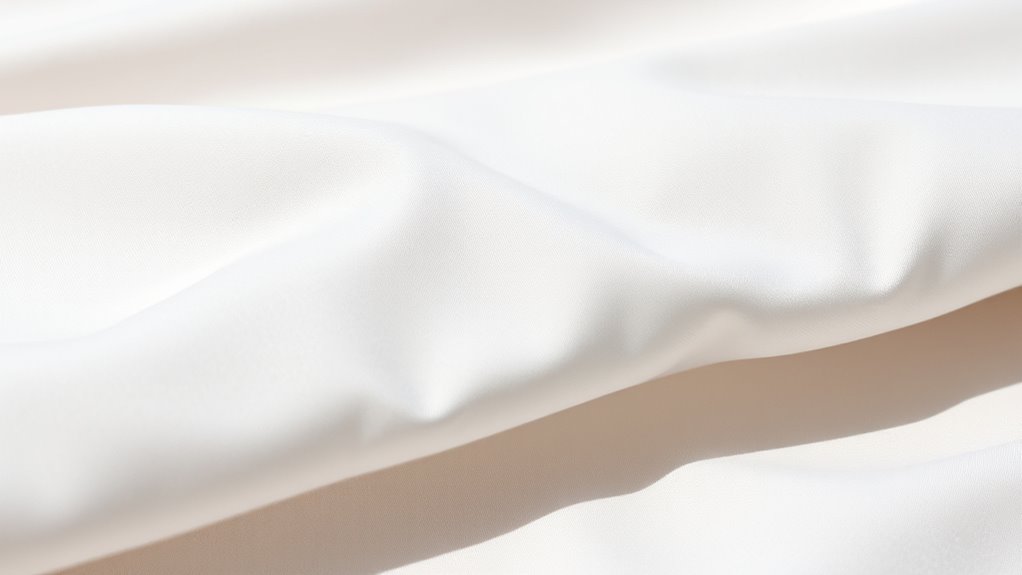
Higher thread counts often feel softer and last longer, but they can also be less breathable. Lower thread counts tend to be cooler and more affordable, yet may wear out faster. Understanding these trade-offs helps you choose sheets that match your comfort and durability needs. Additionally, selecting the right fabric type can further influence both comfort and longevity.
Thread Count Impact
Choosing the right thread count can substantially affect your bedding’s comfort and durability, but the debate over high versus low thread counts isn’t straightforward. Many believe higher thread counts always mean better sheets, but this is a thread count myth. Excessively high counts can sometimes indicate thinner threads woven tightly, which may reduce fabric breathability. Conversely, lower thread counts often feature thicker, more breathable fibers, making them cooler and more comfortable in warm weather. However, fabric breathability isn’t solely determined by thread count; material quality plays a pivotal role. While high thread counts can feel softer, they don’t guarantee superior comfort or longevity. Understanding how thread count impacts breathability helps you select sheets that balance softness with proper airflow, tailored to your preferences. Thread count myths can mislead consumers into making less informed choices about their bedding.
Comfort and Durability
When it comes to comfort and durability, the thread count of your sheets plays a significant role in how they feel and last over time. Higher thread counts often provide smoother, more luxurious finishes, but they can sometimes trap heat. Lower thread counts tend to be more breathable and durable, especially with proper care. Keep in mind that quality materials and eco-friendly dyes also influence longevity and comfort. Here’s a quick comparison: Employing cost-effective strategies can help you select high-quality sheets without overspending.
| Thread Count | Comfort Level | Durability |
|---|---|---|
| High (300+) | Soft, plush, luxury finishes | Less breathable, may wear faster |
| Medium (180-300) | Balanced comfort and durability | Good lifespan, versatile |
| Low (<180) | Crisp, breathable | Highly durable, easy to wash |
Common Natural and Synthetic Fabrics for Sheets
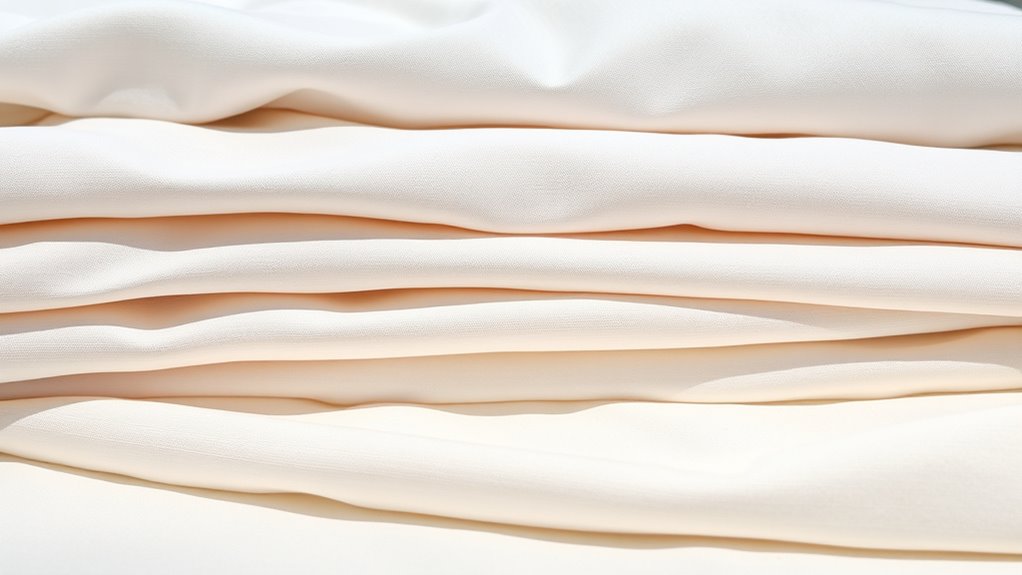
Natural and synthetic fabrics offer a wide range of options for sheet materials, each with unique qualities that can affect comfort and durability. You might prefer fibers like cotton, linen, or bamboo for their breathability and softness. Synthetic options such as polyester and microfiber often provide durability and resistance to wrinkles. Some sheets combine fiber blends to achieve a balance of comfort and longevity. Eco-friendly fabrics, like organic cotton or Tencel, appeal to eco-conscious shoppers. Here are some popular choices:
- Cotton and linen for natural breathability
- Polyester and microfiber for durability
- Fiber blends and eco friendly fabrics for versatile options
Additionally, choosing sheets made from specialized fabrics can enhance features like moisture-wicking and antimicrobial properties, tailored to your needs.
Choosing the right fabric depends on your comfort preferences and sustainability priorities, ensuring your sheets suit your lifestyle.
Tips for Choosing the Right Sheets for Your Lifestyle
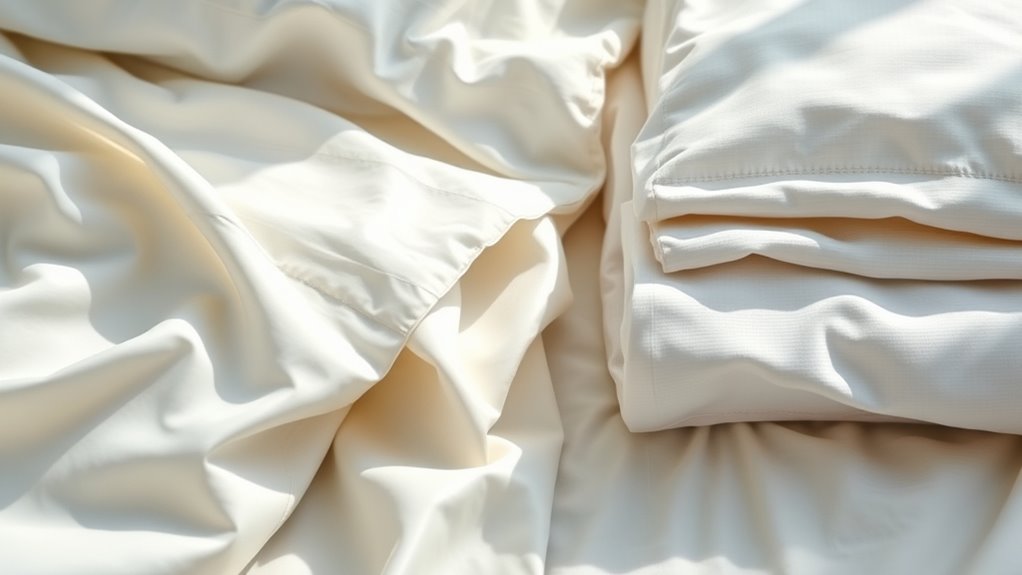
Your lifestyle and daily habits play a significant role in determining the best sheets for you. Don’t fall for thread count myths that suggest higher is always better; comfort and fabric quality matter more. If you sleep hot or live in a warm climate, opt for lightweight, breathable materials like cotton percale or linen for seasonal sheet choices. Conversely, if you prefer cozy, warmer bedding during winter, heavier flannel or brushed cotton can keep you comfortable. Consider your routine—if you tend to sweat or have sensitive skin, prioritize natural fabrics that wick moisture and reduce irritation. Matching your sheets to your lifestyle guarantees better sleep quality and longevity, so choose wisely based on your climate, habits, and comfort preferences. Additionally, selecting appropriate air quality can enhance overall sleep health and comfort.
Caring for Your Sheets to Extend Their Longevity
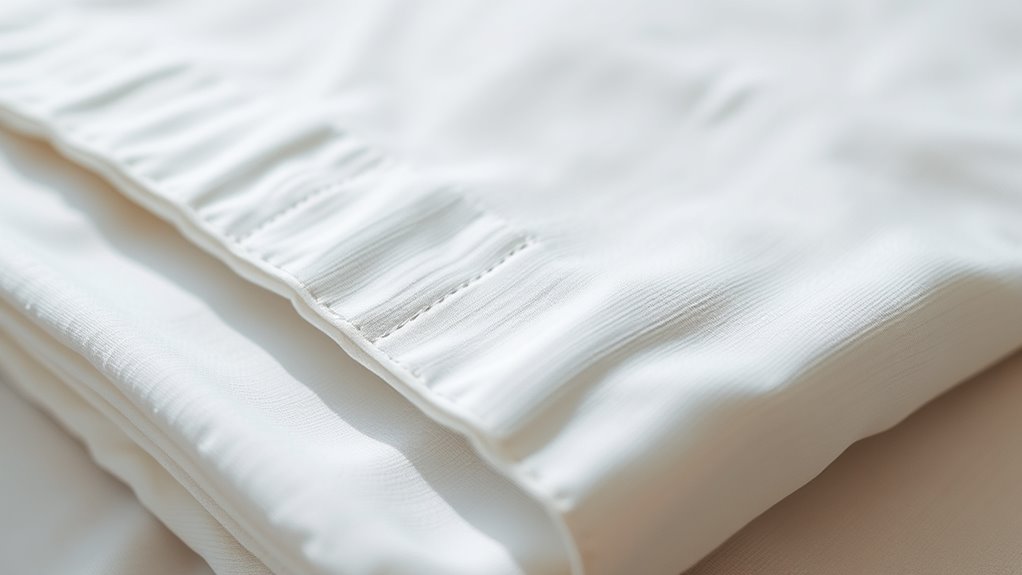
Properly caring for your sheets can substantially extend their lifespan and keep them feeling fresh. Regular laundering, using gentle cycles and cold water, helps preserve the fabric and color. Always follow the care instructions on your bed linen to prevent damage. To maximize longevity, consider these laundering tips:
- Wash sheets separately from heavy items to reduce wear.
- Use mild detergent and avoid bleach unless specified.
- Dry sheets on low heat or air dry to prevent fiber breakdown.
- Incorporate HEPA filtration in your home’s air system to improve overall air quality and reduce dust settling on your bedding.
Taking these simple steps keeps your sheets soft, vibrant, and durable. Proper care not only enhances comfort but also protects your investment in quality bed linen. Consistent, gentle laundering ensures your sheets stay fresh and last longer, saving you money and effort in the long run.
Budget-Friendly Options Without Sacrificing Comfort
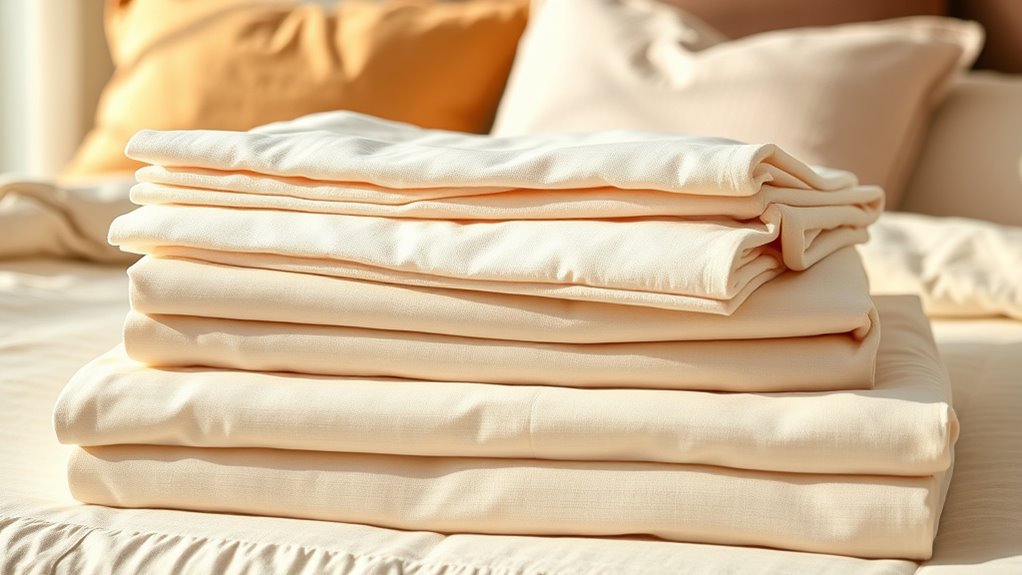
Achieving a comfortable and inviting bed doesn’t have to break the bank. Many believe higher thread counts always mean better quality, but that’s a thread count myth. Instead, focus on fabric blending, which combines fibers like cotton and polyester to create affordable sheets that feel soft and durable. These blends often provide the comfort of natural fibers without the higher price tag. Look for sheets labeled with a moderate thread count—around 200 to 400—since anything higher isn’t necessarily better and can even reduce breathability. Additionally, understanding self watering plant pots can help you appreciate how different materials and designs impact overall quality and longevity of your sheets. By choosing fabric blends wisely, you get a balance of softness, durability, and cost-effectiveness. You don’t need to overspend to enjoy cozy, quality sheets that keep you comfortable night after night.
Frequently Asked Questions
How Does Thread Count Affect Sheet Durability Over Time?
You might think higher thread counts mean better durability, but fiber quality and weave patterns matter more. With good-quality fibers, sheets stay strong longer, regardless of thread count. A tight weave pattern adds durability and prevents fraying over time. So, focus on the fiber quality and weave style, not just the thread count, to guarantee your sheets last and stay comfortable through many washes.
Are Higher Thread Counts Always Softer?
They say “not everything that glitters is gold,” and the same applies to thread counts. Higher thread counts aren’t always softer; many thread count myths suggest otherwise. The sheet thread hierarchy shows that beyond a certain point, increased thread count doesn’t mean better quality or softness. Instead, focus on the fiber type and weave, which play a bigger role in comfort than just a high thread count.
Which Sheet Materials Are Best for Sensitive Skin?
If you have sensitive skin, look for sheets made from hypoallergenic fabrics and natural fiber options. Materials like organic cotton, bamboo, and silk are gentle and less likely to cause irritation. Avoid synthetic fibers, which can be harsh. Choosing these natural, hypoallergenic materials guarantees a comfortable, irritation-free sleep experience, giving you peace of mind and a softer touch on your skin every night.
How Do I Identify Genuine Quality Sheets?
To identify genuine quality sheets, start by examining the cotton fiber types, like Egyptian or Pima, which indicate higher quality. Feel the fabric’s softness and durability, and check for tight, even weaves. Look at the thread count, but don’t rely solely on it; lower counts can still be quality if woven well. Follow sheet care tips, like washing in gentle cycles, to maintain their quality and longevity.
Can Thread Count Indicate Sheet Breathability?
Thread count alone doesn’t determine sheet breathability; fiber types are more important. High thread counts might seem better, but thread count myths can mislead you into thinking thicker sheets are more breathable. Natural fibers like cotton or linen allow better airflow, making them more breathable regardless of thread count. So, focus on fiber types rather than just thread count, and don’t fall for the myth that higher counts always mean better breathability.
Conclusion
Choosing the right sheets is like finding the perfect dance partner—comfortable, reliable, and a joy to be with. By understanding thread counts, materials, and care tips, you can make informed decisions that turn your bed into a cozy retreat. Don’t settle for less—your best sleep is within reach. With a little knowledge, you’ll orchestrate a symphony of comfort every night, making sweet dreams your new normal.
